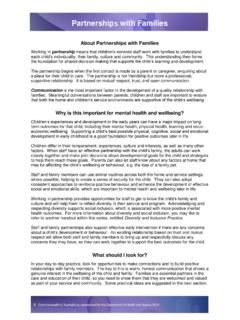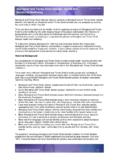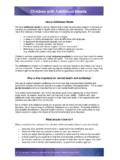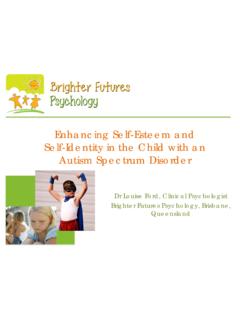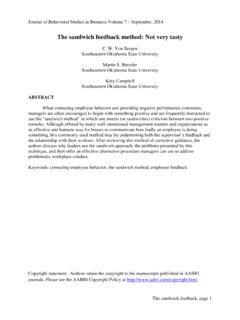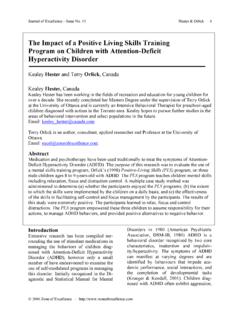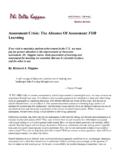Transcription of Communicating with Children - Response Ability
1 Commonwealth of Australia as represented by the Department of Health and Ageing 2010 About Communicating with Children Communication is an exchange of information, ideas or feelings. It can be both verbal and non-verbal. Children are Communicating with their families and carers from the day they are born. Babies and young Children communicate through non-verbal means like eye contact, facial expressions, gestures and movement, as well as sounds such as crying, gurgling, laughing and babbling. Toddlers and older Children learn how to use language to communicate, in addition to non-verbal strategies. Adults acknowledge Children s communication and respond to it through their actions and through their own verbal and non-verbal forms of communication. Why is this important for mental health and wellbeing?
2 When adults use positive communication styles with Children , this supports and promotes a child s social and emotional wellbeing and future mental health in several ways. In babies and young Children , providing responsive care that addresses a child s physical and emotional needs promotes secure attachment and positive social and emotional development, which supports mental health and wellbeing (for more information refer to the handout on Attachment and Mental Health). Meeting a child s emotional needs includes acknowledging his or her early efforts at communication and responding with warmth and encouragement. Positive communication with Children is also important because Children learn about social interactions and communication by observing and imitating others and receiving feedback. If adults model caring and respectful communication with everyone, Children are more likely to develop good social skills and the capacity for positive relationships, which promote wellbeing.
3 Another factor is the child s self-concept, which emerges from 2 to 6 years of age. This is a mental picture or idea about who we are, made up of various components such as: how we view ourselves; how we think others see us; whether we feel valued and cared for; and whether we have a sense of being competent and able to do things. Communication from adults that is caring and constructive can support the development of a positive self-concept in a child. If adults are not responsive, are uncaring, or give mainly insensitive feedback and criticism, a child may develop poor self-esteem and a negative self-concept. If poor self-esteem persists into adolescence or adulthood, there is a greater risk of emotional problems and depression. What should I look for? In your daily practice, look for opportunities to have caring and meaningful communication with babies and Children , being aware of both verbal and non-verbal communication.
4 Even routine tasks like nappy changing and meal times can provide an opportunity for positive interactions. Observe Children s communication throughout the day and consider whether what you observe seems to be developmentally appropriate for each child. Be aware that some differences may reflect temperament or culture and Children may speak a language other than English at home. Some Children have additional needs in regard to language or communication. If there are ongoing concerns, Children and families may need assessment and support from an external agency or a health professional. Difficulties with communication can occur on their own, or they may be associated with other problems, such as hearing loss or autism spectrum disorders. Communicating with Children Commonwealth of Australia as represented by the Department of Health and Ageing 2010 What should I do?
5 Remember that Children will notice both your verbal and non-verbal communication, so you need to be aware of both when you are guiding and interacting with Children . Things to do: Model respectful communication practices at all times with adults and Children Use communication that is appropriate to the developmental stage of the child Use communication that is child-centred, reflecting the child s needs and interests Smile and use positive facial expressions and other forms of non-verbal communication Maintain eye contact with babies and young Children where culturally appropriate Get down to the same level as a child to gain their attention while talking to them Keep instructions simple and specific when asking Children to do something Take time to actively listen to Children , showing interest in their ideas and activities Talk with Children , not at them.
6 And be patient as they communicate with you Praise and thank Children for positive behaviour and acknowledge their achievements Organise the environment in a way that invites interaction and communication Respect the feelings and opinions of Children , no matter how young they are Use open ended questions or statements to encourage Children to communicate their own thoughts, feelings and ideas, , Tell me about your drawing .. Things to avoid: Criticising or blaming Children or being judgemental Lecturing, ordering or threatening Children Talking to a child with your back turned or as you walk away Using or tolerating sarcasm, anger, put-downs or name-calling Impatient body language rolling your eyes, sighing or tapping your foot Diminishing praise, , Thank you for cleaning up I wish you did that every time.
7 If you become concerned about a child s communication or development, observe the child carefully and write down your concerns, along with anything you know about the child s health or family situation that might be relevant. Then speak with your supervisor, coordinator or service director about supporting the child and if necessary referring to another agency. Where can I find out more? Faulkner, J. (2005). Talking with babies and toddlers. Extract from NCAC Newsletter Putting Children First, (14), 6-7. Retrieved 1 April, 2009, from: Kearns, K., & Austin, B. (2007). Frameworks for learning and development (pp. 217-253). Frenchs Forest NSW: Pearson Education Australia. Nixon, D., & Gould, K. (2000). Emerging: Child development in the first three years (2nd ed. ).Katoomba, NSW: Australia: Social Science Press.
8 Zero to Three. (2009). Communication skills. Retrieved 15 May, 2009, from
